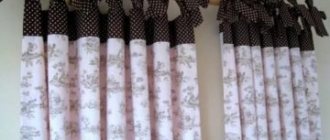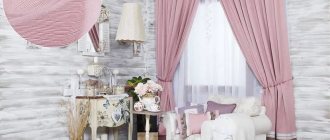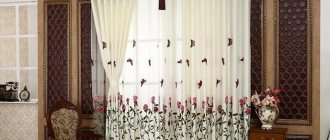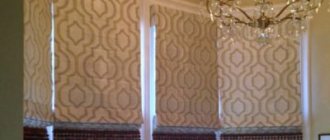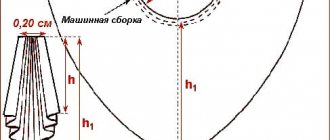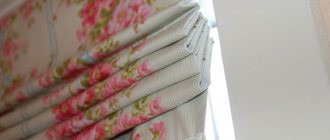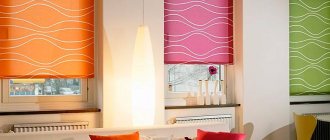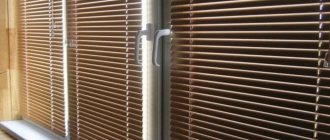Japanese style in the interior, despite its obvious minimalism in the choice of materials and visual aids, is extremely popular when decorating luxury housing. Spacious apartments, lofts in Scandinavian, European oriental style, built on the principle of open space, require careful zoning.
Japanese curtains are functionality and elegance.
Japanese curtains and partitions help highlight functional areas without interfering with the architecture of the home. They leave the opportunity to change proportions and combine space at any time. You can make such curtains with your own hands without spending a lot of time and effort.
They can be confidently called an exotic decorative element that came to us from the land of the rising sun.
Briefly about Japanese curtains and partitions, design features
The basic principle that governs light Japanese partitions is simple lines, discreet colors, and elegance of design. They are used not only to decorate window openings, but also to create partitions in the room, decorate arches and passages.
They are similar in design to vertical blinds.
The entire curtain consists of separate interconnected panels, which can be from 2 to 5, sometimes more. Each part has a rectangular shape, a width of no more than 1 meter, and a length from ceiling to floor. In some cases, it can be reduced as necessary to the level of the window sill.
Each panel is reinforced with a frame, and the fabric on it is straightened and has no folds or draperies.
Such blinds are mounted on a cornice with several guides, the number of which coincides with the number of panels or is a multiple of it. Each is located on its own guide and moves freely to the side. Japanese curtains can be assembled to the width of one panel, like a folding mobile partition. Hanging with a ladder or cascade is popular.
Japanese curtains consist of fabric panels with special weights at the bottom of the curtains, which move along the curtain rod using different types of controls.
Japanese partitions look good on large “French windows” to the floor, on wide window openings. They are used in a large kitchen to separate the workspace from the eating area or to separate the kitchen and dining room when the apartment is built on an open principle.
Japanese curtains are easy to use and care for.
The advantages of Japanese curtains are their mobility, ergonomics, and ease of care. Such panels do not collect dust, since there are no folds or gathers on them. As a rule, fabrics are natural and can be treated with dust-repellent and antistatic impregnations.
The special fastening allows them to be used not only as decoration for a window opening, but also as a partition to divide a room.
It is very convenient to use photo printing as a design, creating real paintings. For control, both the simplest manual and industrial electric mechanisms are used. The curtains can be replaced with new ones as often as the owner wants.
Thanks to the multi-panel design, you can combine the canvases in any order and create stylish and interesting images.
Sewing instructions
Main parameters of curtains:
- the classic width of panels of Japanese curtains is 0.6 m. This is the length that standard curtain rod holders are made for attaching such curtains;
- Japanese curtain panels, as a rule, cover not only the window, but also the entire wall on which it is located;
- curtain screens are placed end-to-end or with slight overlap on the cornice;
- The height of the panels can be any, but they are usually made floor-length.
How to sew Japanese curtains with your own hands
Due to the simplicity of the design and clear principles of operation, Japanese curtains and partitions can be sewn yourself. Choose fabrics with a simple texture, focusing on composition and pattern. Plainly dyed canvases or photo prints are convenient.
Due to their laconic appearance, curtains take up minimal space.
There is a technology for applying perforation that allows you to add more light transmittance if the partition needs to be made as light as possible. This is convenient if the kitchen separates the stove and sink from the table.
Light translucent fabric hides unnecessary details, but allows enough light to pass through.
The materials used are both light, translucent, and dense, heavy, not transmitting light. Among the fabrics, traditional ones come first:
- linen;
- cotton;
- in Japanese traditions - silk;
- jute;
- bamboo;
- imitation rice paper;
- budget - plastic.
Artificial and natural materials are used to make Japanese paintings.
For independent sewing you will need tools - a machine, threads and needles, scissors, guides and weights according to the size of each panel and in accordance with their number, a curtain rod with several guides, fastening accessories for the curtain rod and hooks for hanging curtains.
It is convenient to buy a ready-made cornice, but you can also adapt the profile yourself.
Drawings and patterns of Japanese curtains
When starting work on Japanese panels, you need to calculate the amount of material. In the classic version, the width of each strip is 60 cm, but it all depends on the proportions of a particular room. The length is equal to the distance from the cornice to the floor, that is, the height of the room plus 10 cm for allowances. If the partition is located along the width of the room, then the number of panels is calculated using the formula width divided by 60. Based on these data (number of strips, their length and width), the total amount of material is determined.
Don't forget to allow for edge finishing.
Important! If the number in the calculation turns out to be fractional, it is rounded up, since the easiest way to adjust the size is by changing the hem value.
Pay attention to the width of the fabric. Most often, canvases from 100 cm are found on sale. If you choose the 140-150 cm option, then from one cut along the length you will get two finished canvases. The length of the guides (room height minus 5 cm) and the width of the weights (across the width of each curtain - 60 cm) are calculated in the same way. Their quantity is 2 guides per blade and 1 weighting material.
Special weighting material for Japanese curtains.
How to sew curtains, instructions with photos
Sewing Japanese curtains is quite simple, the main difficulty is that the seams are long, so manual processing is undesirable; it is better to use a sewing machine. Step-by-step instructions will demonstrate in detail how to make Japanese curtains with your own hands. Remember that if the fabric is capable of shrinking, before cutting it must be moistened and ironed so that the curtains do not shrink during the first wash.
Japanese panels come only short or floor-length, all other forms are excluded.
Important! When cutting, it is necessary to accurately observe the direction of the main thread on the fabric so that the curtains do not warp.
- When cutting is completed, the sides of the canvases are processed first. Do not pull the stitching so that the fabric does not wrinkle. Having completed this stage, iron the material well, as this will be difficult to do afterwards. Remember to leave a hole into which the guides will be inserted.
- The second stage is to adjust the top edge. It must be made in such a way that rings or special hooks can be sewn onto it for threading into the guides. Special loop-hooks are sold in the department, next to the department of cornices and curtain rails.
- Lightweight fabrics can be attached to Velcro tape, then one of the parts of the tape is sewn along the upper edge of the fabric, and the second side of the tape is glued to the cornice with mounting glue or tape.
Japanese curtains can be either a decorative element for windows or an excellent solution for decorating niches, walls, and doorways.
- You can use guides suspended from the cornice in the same way as regular curtains on hooks.
- Finally, the bottom edge is stitched. All hems are made with a width of 5 cm, so that structural elements can be inserted inside, in this case weights.
- Hanging Japanese curtains is done in an extended state; it is most convenient to use a curtain rod.
Don't forget to have a long pole to move the curtains when they are ready.
Fabric measurements and calculations
- Measure the width of the window opening or wall, divide it by 0.6 m and round the resulting fractional result up - this will be the required number of panels.
- Measure the height of the room from the floor to the cornice, add 0.2 m to it for hemming the top and bottom edges - this will be the length of the blank for one panel.
- Multiply the length of the workpiece by the number of screens and thus find out the total length of the required material.
- Taking into account the fact that the width of almost all modern fabrics is 1.4 -1.5 m (which means that two identical pieces of 0.6 m wide each can be cut from one piece of material), divide the total length by 2 - this is and there will be the required footage. If the number of canvases is odd, round the result up.
Advice. When choosing fabric for Japanese curtains, give preference to natural or mixed curtain fabrics of light color - plain with an original, pronounced texture, or printed, with an elegant, dim pattern in the form of stripes, bamboo or cherry branches, hieroglyphs or abstract geometric patterns.
The width of one panel of Japanese curtains is usually 0.6 meters
Photo printing on Japanese curtains
The most original way, fully consistent with the traditions of their native country, is photo printing. It can be easily ordered at a copy center or online.
When photo printing, a design of the customer's choice or from the company's catalog is applied to the canvas.
The Japanese motifs of photo prints are dominated by flowers, birds, and landscapes in watercolor style. However, ordinary photographs look no less attractive. The print is applied to several canvases (this creates a single panel) or only to the central one.
These can be paintings of nature, abstract drawings, reproductions.
The best way to apply photo prints is the sublimation method. The name is based on the characteristics of the paint used - sublimation. The paint is not poured or printed onto the fabric, but evaporates from the tracing paper onto the product when heated.
This way, inaccuracies in pattern transfer are avoided and impeccable image quality is obtained.
Important! Grain, image clarity, color rendition and other characteristics depend on the quality of the material provided, image file format, number of pixels and size.
Dividing a room with Japanese curtains
Japanese panels are very often used for zoning rooms. The most popular place to place them is the kitchen. In general, this is fully consistent with how these partitions have been used to furnish homes in Japan since ancient times.
Nothing has changed since then, since the main advantage of this method is ease and mobility.
This is why people love to hang Japanese curtains in the kitchen, separating a part of the room where you can sit quietly, talk, eat or relax with a cup of tea.
This is a stylish solution that can be quickly changed by moving the cornice to a new location.
It is most convenient if there is some structural element in the room that enhances the impression of the curtains. This could be an arch, a ceiling beam, a column, which are often found in studio apartments. Despite the fact that initially Japanese partitions were more often used in large rooms, they also look great in small rooms.
In this case, choose light, translucent fabrics.
Which material to choose
Creating curtains in this style requires a panel made of natural fabrics: cotton or linen. It was from such materials that such curtains were originally sewn. Therefore, when sewing such curtains, you should choose only natural fabrics. Due to the particular location of the screens, it is desirable that the fabrics be heavy. In addition, it is necessary that they do not stretch over time.
In addition, a prerequisite when choosing fabrics is their ideal smoothness with the absence of any folds. The material must be perfectly ironed and even, there should not be a single bend or fold on it. Particular attention should be paid to this point in fabric processing.
The best examples and photos of using Japanese curtains and partitions in the interior
Recommendations from stylists state that Japanese design is fundamentally environmentally friendly, natural, natural. The best photographs show interiors in shades of sky, grass, and water. These are diluted shades of green, pistachio, mint shades, sand, beige, vanilla, pink and blue tones, azure, gray-silver colors.
Japanese curtains provide unlimited freedom when decorating any room.
Harmony is what a Japanese-style partition brings to the interior. They add airiness and volume to the space and do not obscure the room. To add expressiveness, it is worth using more saturated orange tones, lemon, red, green.
You can combine light and more saturated colors, transparent and dense texture.
A little history
Already by the name you can determine that the birthplace of these outlandish paintings is the Land of the Rising Sun. Their history dates back to the 13th century, although in those distant times they looked, of course, differently.
Japanese curtains resemble panels or vertical blinds.
Today, thanks to modern technology, Japanese curtains have become more advanced. Although, according to most designers, they are more decorative than a functional part of the interior.
Nowadays, Japanese curtains have become a decorative element of the interior.
